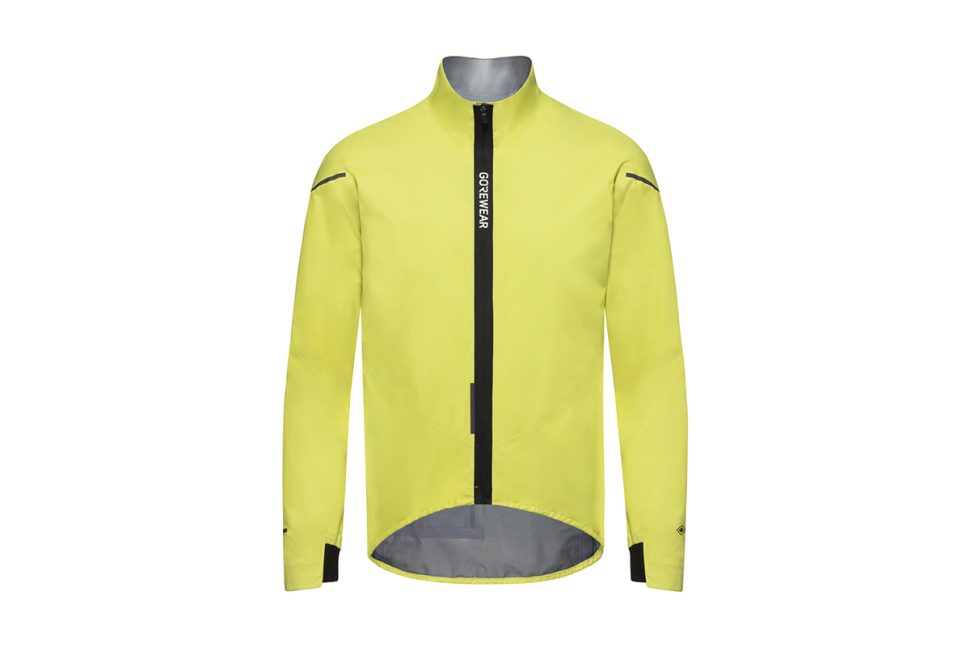Cyclist
Home and dry? The latest next-generation rain jackets
No one likes getting wet, but it’s probably preferable to ingesting chemicals that pollute our bodies at a cellular level. Polyfluoroalkyl substances – PFAS – are a group of synthetic chemicals widely found in consumer products and they have long been used in DWR (durable water repellent) coatings on cycling rain jackets. However, due to their glacial decomposition rate, their environmental impact is colossal.
‘They are present in everything chemical,’ says Fergus Niland, creative director at Santini. ‘Toiletries, electronics, kitchenware, packaging… practically any consumer item could contain PFAS.’
Widely known as ‘forever chemicals’, they find their way into the food chain and have been discovered in everything from the cells of livestock and fish to the umbilical cords of babies.
So what made PFAS work so well in cycling apparel?

‘PFAS-coated materials have a very low surface energy, which means rain beads off naturally,’ says Anne Weir, ex-Gore and now materials developer at Rapha. ‘They’re also resistant to stains and oil, which protects the textile material. The membranes don’t contaminate easily so they remain breathable and waterproof for longer.’
Gore is one of the few companies that produces both apparel and the high-performance fabrics they’re made from. Most brands collaborate with a laminate supplier to produce water-resistant kit, of which Gore, Polartec and Pertex are among the best known, and all have begun to phase out PFAS.
‘From a moral, ecological and legal point of view, we as designers have to adapt,’ says Niland at Santini. ‘From January 2025 there is European legislation coming in to govern PFAS.’
Crossing the threshold
Adapt they have, with the main laminate producers all adopting a multi-layered, membrane-based textile to try to emulate PFAS.
‘The new chemistries are fluorine-free and have a different composition,’ says Weir. ‘They are usually silicone or bio based and quite good at repelling water and beading, plus the material is lighter. However, neither of them has oil repellency so the contamination aspect is a key worry for us.’
The scientific process that occurs in the new polyurethane (PU) membranes to create a breathable jacket relies on the transaction between the inside and outside of the fabric.
‘Riding hard on a crisp, winter’s day, the interior will be damp and sweaty, the outside dry and cold,’ says Graeme Raeburn, head of design at clothing company Albion. ‘Most post-PFAS membranes absorb moisture from the inside and move it to the dry exterior.’
Niland says Polartec’s molecular diffusion technology, used by Santini, works in a similar way: ‘Imagine the way in which a leaf on a plant would absorb light or water or nutrients, but at the same time be able to block out water.’
The question remains as to whether these new technologies will perform as well as their forebears. British brand Le Col works with laminate suppliers Pertex and Polartec on rainwear, and senior designer Binny Borwick has noticed a period of transition.
‘There was a drop off in performance as brands tried to transition away from PFAS,’ she says. Similarly, according to Raeburn, ‘The chemical and physical repellency of fluorine-based chemistry will never be surpassed due to its position in the periodic table. So yes, there is a difference in durability.’
Performance Gore-Tex jackets now contain ePE (expanded polyethylene) membranes, and Catriona Shearer from Gore explains, ‘Jackets will appear to wet out more. The beading won’t happen for as long because of the transfer of oils. But it’s important to understand that it’s nothing to do with the performance of the membrane – that will continue to function.’
Succeeding a material that has been so popular and effective is no mean feat. But the way forward – as with most environmental conundrums – will require consumers to channel a degree of responsibility into how they care for their possessions.
Finn Abbot-Wright, wear testing coordinator at Rapha, says that rather than a dramatic drop in waterproofing or breathability, the main improvement will need to be in diligent maintenance.
‘It’s essential that jackets are cleaned correctly, reproofed periodically and that contaminants – anything that could affect the beading – are removed.’
• This article originally appeared in issue 158 of Cyclist magazine. Click here to subscribe
A selection of the latest PFAS-free rain jackets

Q36.5 Rain Shell, £304 | q36-5.com

Le Col ARC Lightweight, £280 | lecol.cc

Pas Normal Studios Mechanism Pertex, £250 | pasnormalstudios.com

Santini Guard Neos £320 | santinicycling.com

Rapha Gore-Tex, £300 | rapha.cc

Poc The Supreme, £450 | poc.com

Albion All Road Pertex Shield, £210 | albioncycling.com

Gorewear Spinshift Gore-Tex, £249.99 | gorewear.com
The post Home and dry? The latest next-generation rain jackets appeared first on Cyclist.
